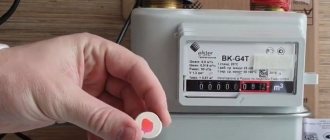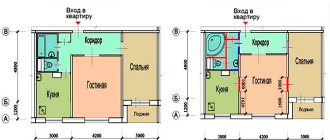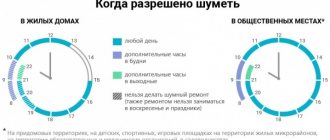Calculation of drainage according to the standard
‘);} //—>
');} //—> Water disposal according to the standard is the amount of wastewater discharged by the consumer into the sewerage network without installing water meters in a house or apartment. The formula for calculating water disposal according to the standard: P = n * N * T * k, where P is the price of water disposal in rubles; n is the number of people living in the house or apartment; N - standard water disposal per person; T—water disposal tariff in rubles per m3; k—increasing factor (if available). See also - balance of water consumption and wastewater disposal. You can quickly perform this economic (accounting) calculation using our online program. To do this, enter the initial value in the appropriate field and click the button.
This page presents the simplest online calculator for calculating sewerage according to the standard, depending on the number of residents, the standard, the tariff and the increasing factor. To calculate the cost of sewerage according to the standard, you need to know the tariff, standard, number of residents and the need to apply an increasing factor.
The housing and communal services receipt, among other things, includes an item on payment for water drainage. It includes not only the sewage system, but also the water that flows into the drain holes of the bathtub and sink. Water disposal is calculated using special formulas. The calculation method depends on whether you have water meters.
Examples of calculating water consumption and wastewater disposal
The load on pipelines and devices that ensure an uninterrupted supply of water to various sanitary equipment (kitchen sink, bathroom faucet, toilet, etc.) depends on its consumption rates.
When calculating water consumption, the maximum water consumption per day, hour and second is determined (both total and cold and hot separately). There is a calculation method for water drainage.
Based on the results obtained, the parameters of the water supply system are established according to SNiP 2.04.01-85 - “Internal water supply and sewerage of buildings” and some additional ones (meter passage diameter, etc.).
Example 1: calculating volume using formulas
A private cottage with a gas water heater, 4 people live in it. Plumbing fixtures:
- faucet in the bathroom – 1;
- toilet with flush cistern in the bathroom – 1;
- faucet in the kitchen sink - 1.
It is necessary to calculate the water flow and select the cross-section of the supply pipes in the bathroom, toilet, kitchen, as well as the minimum diameter of the inlet pipe - the one that connects the house to a centralized system or source of water supply. Other parameters from the mentioned building codes and rules are not relevant for a private house.
1. Water consumption (max) per 1 second. calculated by the formula:
Qsec = 5×q×k (l/sec), where:
q – water flow per 1 second. for one device according to paragraph 3.2. For the bathroom, toilet and kitchen - 0.25 l/sec, 0.1 l/sec, 0.12 l/sec, respectively (Appendix 2).
k – coefficient from Appendix 4. Determined by the probability of action of plumbing (P) and their number (n).
2. Define P:
P = (m×q1)/(q×n×3600), where
m – people, m = 4 people;
q1 – total maximum rate of water consumption for the hour of greatest consumption, q1 = 10.5 l/hour (Appendix 3, presence of water supply in the house, bathroom, gas water heater, sewer);
q – water consumption for one device per 1 second;
n – number of plumbing units, n = 3.
Note: since the value of q is different, we replace q * n by summing the corresponding digits.
P = (4×10.5)/((0.25+0.1+0.12)×3600) = 0.0248
3. Knowing P and n, we determine k according to Table 2 of Appendix 4:
k = 0.226 – bathroom, toilet, kitchen (based on n × P, i.e. 1×0.0248 = 0.0248)
k = 0.310 – cottage as a whole (based on n × P, i.e. 3x0.0248 = 0.0744)
4. Define Qsec:
bathroom Qsec = 5×0.25×0.226 = 0.283 l/sec
bathroom Qsec = 5×0.1×0.226 = 0.113 l/sec
kitchen Qsec = 5×0.12×0.226 = 0.136 l/sec
cottage as a whole Qsec = 5×(0.25+0.1+0.12)×0.310 = 0.535 l/sec
So, the water flow is obtained. Let us now calculate the cross-section (internal diameter) of the pipes using the formula:
D = √((4× Qsec)/(PI×V)) (m), where:
V – water flow speed, m/sec. V = 2.5 m/s according to paragraph 7.6;
Qsec – water consumption in 1 sec., m 3 /sec.
bathroom D = √((4×0.283/1000)/(3.14×2.5)) = 0.012 m or 12 mm
bathroom D = √((4×0.113/1000)/(3.14×2.5)) = 0.0076 m or 7.6 mm
kitchen D = √((4×0.136/1000)/(3.14×2.5)) = 0.0083 m or 8.3 mm
cottage as a whole D = √((4×0.535/1000)/(3.14×2.5)) = 0.0165 m or 16.5 mm
Thus, a pipe with an internal cross-section of at least 12 mm is required for a bathroom, 7.6 mm for a bathroom, and 8.3 mm for a kitchen sink. The minimum diameter of the inlet pipe for supplying 3 plumbing fixtures is 16.5 mm.
Example 2: simplified definition
Those who are intimidated by the abundance of formulas can make a simpler calculation.
It is believed that the average person consumes 200-250 liters of water per day. Then daily consumption for a family of 4 people will be 800-1000 liters, and monthly consumption will be 24,000-30,000 liters (24-30 cubic meters). In private houses in the courtyards there are swimming pools, outdoor showers, drip irrigation systems, i.e. part of the water consumption is irrevocably carried out onto the street.
Water consumption is increasing, but there is still a suspicion that the approximate standard of 200-250 liters is unreasonably high. And indeed, after installing water meters, the same family, without changing their everyday habits, adds 12-15 cubic meters to the meter. m, and in economy mode it turns out even less - 8-10 cubic meters. m.
The principle of drainage in a city apartment is this: as much water as we consume, we pour into the sewer. Consequently, without a meter they will count up to 30 cubic meters. m, and with a meter - no more than 15 cubic meters. m. Since in the private sector not all consumed water goes back to the sewer system, it would be fair to use a reduction factor when calculating water disposal: 12-15 cubic meters × 0.9 = 10.8-13.5 cubic meters. m.
Both examples are conditional, but a table with a real calculation of water consumption and disposal, which can only be done by a qualified engineer, should be available to all economic entities (enterprises, housing stock) that collect water for drinking, sanitary and hygienic, industrial needs and discharge drains.
Responsibility for the reliability of the data used in the calculation rests with the water user.
What is drainage
There is a clear formulation of this service. It is enshrined in Decree of the Government of the Russian Federation No. 354 of 05/06/2011. This is a set of procedures that is needed to remove household wastewater from apartments through the connection network. The process of removing and filtering water has several stages. When a meter is installed, the indicator is calculated based on the water used and the regional tariff. Every citizen-consumer must pay for sewerage.
In other words, water disposal is the purification of water and disposal by discharge into the sewer. Draining water when washing your face, after a shower, or from the dishwasher is all water drainage.
Water disposal is regulated on the basis of the following documents:
- Law on water supply and sanitation (dated 07.12.2011 N 416-FZ)
- Official regulations and orders at the local and regional level;
- Internal provisions of city water utilities.
What is regulated by the Federal Law “On Water Supply and Sanitation”
The State Duma adopted the normative act back in 2011. But the federal law is still in force today. Amendments and changes are being made to it to comply with modern realities. The document regulates all relationships in the field of drinking water supply and sewage disposal.
The main points that are subject to legislative regulation:
- The quality and safety of moisture supplied to consumers through cold and hot water supply networks, including open water supply from heat supply sources. This is necessary to create a favorable sanitary and epidemiological situation in the country.
- Safety of household and industrial wastewater that is discharged into water bodies.
- Rules for the supply of hot water and ensuring its quality.
- Commercial accounting of drinking moisture and wastewater, that is, determination of the volumes of water supplied and received over a certain time using meters or a calculation method.
Quality and safety mean a set of water characteristics, including physicochemical, biological, organoleptic indicators, including temperature properties.
The nuances of water supply to military and defense facilities are established by additional decrees of the Russian government.
How is this item shown on receipts?
Many people believe that the drainage of water resources includes only discharge into the sewerage system. In reality, the service includes the removal of a water resource after use and delivery to treatment facilities, its filtration, and so on.
If we talk about the monthly display of consumption, then if IPU is installed, the item is called - cold water supply (cold water supply) and hot water supply (hot water supply). If there is no IPU in the apartment, then the calculation is carried out based on the standards at the local level. This will appear on the receipt as follows:
- Cold water supply at OI MKD - consumption of cold water in the house;
- DHW t/n at OI MKD – hot water (volume);
- DHW heating at OI MKD - hot water (heat).
Learning the rules
According to the law of July 29, 2013, No. 644 (as amended in December 2020, amended on January 4, 2017) “Rules for cold water supply and sanitation,” there are water consumption standards.
What is covered in the document?
- Consumers of services are individuals, legal entities, as well as state-owned enterprises.
- An algorithm for joining the central system is considered.
- Rules for accounting for received water and disposal of wastewater.
- The persons who must monitor the measuring instruments are indicated.
- Features of the disposal of heavily contaminated wastewater, the procedure for completing and submitting a declaration.
- Standards for monitoring and payment are determined.
When planning and installing communications, remember that it is necessary to create conditions for quick access to devices.
How to calculate water drainage using a meter: formula and example
To calculate water drainage from a meter, you need to use a special formula:
SV = (DHW + cold water) x TV, where
SV – total amount to be paid; DHW – monthly hot water consumption, based on the IPU reading, m3; Cold water consumption - monthly consumption of cold water according to the meter, m3; TV – regional tariff.
This calculation is regulated by the Government Decree “On the procedure and conditions for citizens to pay for housing and utilities.” The regional tariff for each subject of the Russian Federation is individual.
For example, let’s calculate the cost of the service in Moscow. The local regional tariff (TV) is 21.90 rubles/m3. The monthly consumption indicator according to the meter is 10 cubic meters of cold water and 5 cubic meters of hot water. The total consumption of hot and cold water supply is 15 m3.
Substituting known values into the formula, we get:
(5 + 10) x 21.90 = 328.5 rubles.
The owner must repay such an account by the 20th of the next month.
If your sewer payment is late, the city water utility will issue a fine. If repayment of the debt is delayed, the organization will consider that its rights have been violated. Penalties will be accrued daily.
For those who do not want to calculate water drainage by meters themselves, there are specialized portals where you only need to enter the readings. Next, the system will display the amount to be paid.
In case of any controversial situations, you must immediately contact the Management Company for clarification. For example, if after an independent calculation it turns out that the resulting amount is less than that calculated by the city water utility. There have often been cases when employees of the Criminal Code took advantage of the inattention of conscientious citizens and entered increased testimony.
SNiP for water supply and sanitation 2020
Article current as of: May 2020
Paying utility bills every month, we seem to have to get used to a certain amount. Meanwhile, it constantly varies, sometimes increases, sometimes decreases.
Why? What are the tariffs for water supply? What are the accepted standards for water consumption per person in 2020 if individual meters are not installed in the apartment? Let's talk about this in the article.
The legislative framework
The nuances of the provision and consumption of utility services, pricing issues are fixed by a number of regulations:
- Federal Law No. 210-FZ explains the organization of the provision of public services.
- Government Decree No. 354 determined the basic conditions for the provision of public services in residential buildings.
- SNiP 2.04.01-85 “Building Norms and Rules” contains standards for water consumption per day in apartment buildings, dormitories, hotels, and so on.
- Government Decree No. 1498 talks about the provision of public services.
All further information contained in the article will be based on these documents.
Standards and tariffs for consumption, water consumption and sanitation by city for 2020
According to SNiP, each person spends about 140 liters of water per day. This includes:
- taking a shower every day;
- taking a bath;
- washing, brushing teeth;
- flushing the toilet;
- washing dishes, cooking, laundry, etc.
People use cold water more often than hot water. Based on this, the monthly consumption rate is determined - approximately 6.9 cubic meters, hot - 4.7 per person, if meters are not installed in the apartment.
The standard also includes additional liquid costs: maintenance of common areas, pipe burst, temporary increase in pressure.
The supplier company can increase the rate, but not more than 2 times. But they must have good reasons for this.
Based on the standard, the water tariff for consumers is determined. In addition to the base rate, this includes additional coefficients (region, time of day).
Please note that the tariff is calculated not on the number of square meters, not on the number of people living in the apartment, but on everyone registered.
The above numbers are very average. Water consumption may vary. To clarify it, the standards established by law in Russia are taken into account, regional data are taken into account, and compared with apartments that have meters.
When calculating tariffs and standards in the regions, many factors must be taken into account. For example, climate, time of year, state of communications, cost of electricity, etc.
Let's consider regional standards and tariffs.
In Moscow: norms and average water consumption
In Moscow and the Moscow region, classical standards apply - 6.7 for cold water and 4.7 for hot water.
At the same time, the tariff here is the highest in Russia - 38.06 (hot water) and 188.53 (hot water).
In St. Petersburg
In St. Petersburg, the standards are lower than in Moscow: 5.36 (hot water) and 3.89 (hot water). Moreover, the tariff depends on the type of water - drinking (30.60), technical (in non-residential buildings, 6.20) and hot (106.53).
Other cities
The lowest hot water consumption rate in Krasnodar is 2.65. When cold – 4.04. But the price for cold depends on the supplier. And there are more than 30 of them in the region. Prices are different for everyone - from 6.90 at the Progress state farm municipal unitary enterprise to 72.81 at Universal-Plus-Service LLC.
In Samara, the highest standard for cold water is 7.9, for hot water – 3.6. The cost of 1 cube of cold water varies from 26.88 to 37.42 from 7 supplier organizations. Hot water is quite expensive - 130.2 per cubic meter.
The highest hot water consumption rates are in Omsk (5.472) and Yekaterinburg (5.04).
This is important to know: Heating system passport: sample
The regulatory rates are closest to the average in Kazan - 6.73 hvs, 3.44 gvs.
Water disposal standards according to SNIP
All water consumed by humans goes through the sewer system. It must be cleaned to prevent pollution of rivers and other bodies of water.
This system is called drainage. We also pay money for it.
The state has established sewerage standards for residential and non-residential premises that do not have metering devices.
If the house is not connected to the sewer, then the average daily norm for 1 person is 25 liters per day.
For industrial enterprises, more complex calculations are used. This takes into account the total number of employees, the number of products produced, the presence of showers, and more.
About increasing factors
In many apartments, private houses and farms, water, gas and electricity meters are not installed. But the conditions for this exist. An increasing coefficient has been introduced for them since 2020. In 2020 it is 1.5. You can read a separate article about odds on our website. ⇐
How to correctly calculate fees for cold and hot water without a meter, formula and example
To calculate how much water supply services will cost in an apartment that does not have meters (provided that it is possible to install them), use the formula:
P is the required value;
N – standard approved in the region;
K – increasing coefficient;
As a sample, let's take an average family of four people, two adults, two children. They live in Samara. They don't have meters, although they could install them.
The standard for cold water is 7.9, for cold water – 3.6.
The increasing coefficient is 1.5.
Let's take the minimum tariff for the region - 26.88 for hot water, 130.2 for hot water.
Using the calculator we will make simple calculations:
4·7.9·1.5·26.88 = 1274.112 (for cold water)
4·3.6·1.5·130.2 = 2812.32 (for hot)
If it is not possible to install meters in the apartment, then there is no need to multiply by the increasing factor.
4·7.9·26.88 = 849.408 (per hvs)
4·3.6·130.2 = 1874.88 (for hot water)
The total amount turns out to be quite impressive. True, for some categories of the population, for example, people with disabilities, there are discounts.
Meanwhile, according to the counters, the fee comes out much less.
Balance of water consumption and wastewater disposal of a residential building
For a building to function properly, water must flow to several points at once - kitchen, bathroom, shower, basement, and so on. And freely leave through the sewer. Ideally, the volume of incoming and outgoing fluid should be the same.
The balance of water consumption and drainage is used when planning communication systems (including heating), laying pipelines, and connecting to the central water supply.
Drawing up a balance sheet is a complex process. To carry it out, a table in Excel form is used. An example of a table can be obtained from the local city water utility.
In Russia, according to GOST, the average water consumption per person per day is 300 liters. Thus, in order to calculate the average daily expenditure per family according to the standard, you need to multiply the number of its members by 300 and by a multiplying factor (again, it’s impossible without it). The formula is as follows:
There is also a reduction factor. And this is already a pleasant moment. It includes unaccounted water consumption (rush, filtration) and is equal to 10%.
Q ignorant = 0.1 1.3 300 N
As a result, the total water consumption per month for one family is calculated using the formula:
Q total = 300 1.3 N + 0.1 1.3 300 N
By the way, if you install a water meter, the average monthly amount payable will be 2 times less.
When a built house is put into operation, an agreement is drawn up for connection to the water supply and sewer system. And here a balance of water consumption and disposal is also necessary.
But, in addition to the total amount of water used, other factors are taken into account: climate characteristics, landscape, deterioration of communications. Therefore, in order to avoid any mistakes and alterations, it is better to entrust this matter to specialists.
Regulatory documents on the subject of water supply and sanitation
The main regulations are:
- Housing Code.
- Federal Law No. 416-FZ “On Water Supply and Sanitation”.
- Government Decree No. 354 of 05/06/2011 regulating the provision of public services.
Source: https://tvoizakon.ru/snip-po-vodosnabzheniju-i-vodootvedeniju-2019-goda/
How is the fee calculated if there is no meter: example
When there is no meter, the amount on the receipt increases. Thus, monthly consumption will be calculated based on regional standards. There is no need to explain that government standards significantly exceed actual water consumption.
The calculation is made using the formula:
Regional standard * number of registered people in residential premises * tariff.
For example, in Moscow the regional standard is 11.68 m3 per person per month. It is calculated based on the standard for hot water - 4.745 m3 and cold - 6.935 m3.
Registered citizens – 2.
The regional wastewater tariff in Moscow is 21.90 rubles/m3.
Fee calculation: 11.68 * 2 * 21.90 = 511,584 rubles.
The owner will have to pay this amount if he does not have an IPU installed. After submitting the data, the payment center checks the correctness of the calculated indicator and issues a payment order. A payment slip with the estimated amount will arrive in the new month.
Water disposal standard per person 2020
The legal topic is very complex, but in this article we will try to answer the question “Water disposal standard per person 2020.” Of course, if you still have questions, you can consult with lawyers online for free directly on the website.
Of course, such a standard is not established on its own, but taking into account consumption for certain needs. The formula for calculating the payment for hot water is similar to the calculation for cold water using the cost of 1 cubic meter of hot water at the regional tariff.
Should we expect another increase, when will it happen and by how much will the tariff increase? Despite the fact that the annual indexation is only about 4%, for many families consisting of more than three people, costs increase significantly.
Utility consumption standards for 2020
- How are general house standards determined?
- General standards for electricity
- How water supply standards are formed
- What are CG consumption standards, how are they determined and why are they needed?
- Social norms on water use
- Established heating rate ONE
- Established standards for heating this year
- How to pay if citizens do not have individual meters
- Results
If it is not possible to install an IPU in an apartment, it is worth considering installation options for the entire entrance or even an apartment building. In this case, the fee will be calculated taking into account the meter reading and the number of residents in the apartment. This method is relevant for dormitories.
https://www.youtube.com/watch?v=BKTbVmt_kDM
A simple example. Ivanova K.I. lives alone in a 1-room apartment. There is no hot water in the house, so only cold water is paid for. The standard is seven cubic meters. At a cost of 40 rubles, the total water bill is 280 rubles. After installing the IPU, she will pay 80 rubles less for real consumption (five cubic meters).
Formula for calculating cold and hot water without a meter
Payment of the CU without a one and a half-fold increase is possible only in certain cases prescribed in the legislative act. In the utility bill, the coefficient is specified separately from the standard.
The fixed cost in Moscow is formed by local authorities, in St. Petersburg this is the responsibility of a specially created committee. If it turns out that a family uses a certain resource in an amount that even slightly exceeds the norm established in the region, they will have to pay for the excess.
In this case, a higher tariff rate is usually applied. It often happens that citizens see what they think are inflated figures in the payment and try to challenge them by filing an application for recalculation.
If this happens, you need to pay attention to the amount of resource used and compare it with the regional norm.
: We bought bed linen and sold it, what is the OKVD code?
What are CG consumption standards, how are they determined and why are they needed?
- Housing and communal services and management companies have the opportunity to clearly formulate rates for services provided to citizens;
- For each type of utility services, separate consumption standards are established per citizen;
- Set tariffs that can be clearly justified;
- Determine the optimal amount of subsidies.
- the degree of increase in prices for energy resources (natural gas and coal);
- rising electricity prices;
- increasing wages for employees of utility companies and related organizations;
- availability of investment programs.
Water tariffs for the population in Ukraine
The cost for the population is set in accordance with the resolutions of NKREKU (National Commission that carries out state regulation in the fields of energy and utilities). At the same time, the price is not the same for all regions of the country. The cost may vary significantly between different supplying companies, so-called licensees.
What are the tariffs for cold water in Ukraine in 2020?
The schedule for increasing prices for housing and communal services for the population includes a phased increase in electricity tariffs. As for the prices for hot water supply, they were also increased, mainly due to the rise in energy prices.
- according to two-zone tariffs, differentiated by time periods: 67 percent of the volume of electricity consumed at the tariff during the hours of the night minimum load of the power system (from 11 pm to 7 am) and 33 percent of the volume of electricity consumed at the tariff during other hours of the day;
- at tri-zone tariffs differentiated by time periods: 21 percent of the volume of consumed electricity at the tariff during the hours of maximum load of the energy system (from 8 a.m. to 11 a.m. and from 8 p.m. to 10 p.m.), 33 percent of the volume of consumed electricity at the tariff during the half-peak period (from 7 hours to 8 hours, from 11 hours to 20 hours, from 22 hours to 23 hours) and 46 percent of the volume of electricity consumed at the tariff during the hours of the night minimum load of the power system (from 23 hours to 7 hours).
Cold water To use centralized cold water supply services - 2.4 cubic meters. meters per person per month in the presence of a centralized supply of hot water and 4 cubic meters.
meters per person per month in the absence of a centralized hot water supply. In the event of a break in the provision of centralized hot water supply services (for more than 14 days) in the manner prescribed by law - 4 cubic meters.
meter of cold water per person per month.
In the absence of apartment cold water meters, charges for the use of services for the centralized supply of cold water to war invalids and members of their families, who are entitled to benefits in accordance with the law, are charged by the performers/producers of such services in accordance with social standards.
Hot water
To use centralized hot water supply services - 1.6 cubic meters. meters per person per month.
In the absence of apartment hot water metering devices, charges for the use of services for the centralized supply of hot water to war invalids and members of their families, who are entitled to benefits in accordance with the law, are charged by the performers/producers of such services in accordance with social standards.
Sewerage
To use centralized sewerage services - 4 cubic meters. meters per person per month. In the absence of centralized drainage (in the absence of a drainage system and in the presence of centralized water supply and cesspools) for the removal of liquid sewage - 4 cubic meters. meters per person per month.
In the absence of apartment metering devices for cold and/or hot water, charges for the use of centralized water disposal services for war invalids and members of their families, who are entitled to benefits in accordance with the law, are carried out by the performers / producers of such services in accordance with the social standards established by the first paragraph of the subparagraph 2 and/or subparagraph 3 of this paragraph;
Gas supply services
When installing gas meters: - If you have a gas stove and centralized hot water supply - 6 cubic meters. meters per person per month; - If you have a gas stove and there is no centralized hot water supply and gas water heater - 9 cubic meters. meters per person per month; — If you have a gas stove and a gas water heater — 18 cubic meters. meters per person per month;
In the absence of gas meters - see consumption standards in the absence of gas meters
Electricity supply (until December 31, 2017) in residential premises:
ON THIS TOPIC
- in residential premises (houses), except for those specified in paragraphs three to six of this subclause - 70 kWh per month per family (household) per person and an additional 30 kWh per month for each other family member, but not more than 190 kWh per month;
- equipped with stationary electric stoves, in the presence of a centralized supply of hot water - 110 kWh per month per family (household) per person and an additional 30 kWh per month for each other family member (household) per residential premises (house), but no more 230 kWh per month;
- equipped with stationary electric stoves, in the absence of a centralized supply of hot water - 130 kW h per month per family (household) per person and an additional 30 kW h per month for each other family member per residential premises (house), but not more than 250 kW h per month;
- not equipped with stationary electric stoves, in the presence of a centralized supply of cold water and in the absence of a centralized supply of hot water and gas water heating devices - 100 kWh per month per family per person and an additional 30 kWh per month for each other family member (household) per person residential premises (house), but not more than 220 kWh per month;
- in villages and urban-type settlements for citizens for whom, in accordance with the law, the state provides free housing lighting - 30 kWh per month per person.
As a result, it is much more profitable to pay only for the amount that was actually consumed, without overpaying for extra cubic meters of water. And this can only be done if you have an individual meter.
Standard consumption of cold and hot water per person per month without a meter
Formula for calculating the cost of cold water for the owner or tenant of an apartment that is not equipped with individual metering devices, if it is not technically possible to install a meter (RF PP No. 354 Chapter VI, paragraph 42):
Cold water consumption per person without a meter
The standard includes only actual consumption figures for each person and it is believed that no more than 140 liters of hot water are consumed daily for all his needs. The same rule applies here as with cold water, when utility companies can increase the standard no more than twice. And you need to pay according to the standard for each citizen registered in the living space.
: Real estate bills from 1993, how much are they worth in 2020
What you should know about this option:
- the multiplier was introduced in 2014, it is used when a resident does not provide accurate data for water accounting;
- with installed meters - begins to operate three months after the device is recognized as faulty or upon receipt of a refusal to check by a housing and communal services specialist;
- in recent years, the coefficient has increased from 1.1 in 2020 to 1.5 in 2020.
Consumption standards for hot and cold water per person per month without a meter - consumption standards for hot and cold water per day in 2020
It is difficult to take into account the average for two reasons - individual figures for regions of the country and most regions. Consumption is strongly influenced by climate conditions, since in the North the consumption of hot water is higher. Additionally, the season matters.
Rules for calculating payments
According to statistical information, a citizen consumes about one hundred liters daily. Consequently, the monthly consumption of hot water per person according to the standard is about 3000 liters. DHW used in the heating system is not included in this article, so the fee is charged additionally.
3. Water consumption for production needs not indicated in this table should be taken in accordance with technological specifications and instructions for construction design of enterprises in individual industries.
4. For water consumers of civil buildings, structures and premises not listed in this table, water consumption standards should be adopted in accordance with this appendix for consumers similar in the nature of water consumption.
Filters for water
Notes: 1. Water consumption standards are established for main consumers and include all additional costs (service personnel, showers for service personnel, visitors, cleaning of premises, etc.).
To determine that when establishing standards for the consumption of utilities for heating, cold water supply, hot water supply, and sanitation in St. Petersburg, the analogue method was used.
Water Disposal Standard Per Person Without Meter From 2020
Timely payment of utility bills is the responsibility of everyone who uses housing and communal services or other services that supply gas, water, electricity and other resources necessary for normal living conditions.
Consumption standards for hot and cold water per person
The water consumption rate established by local authorities is used in circumstances where consumption meters (meters) are not installed in the apartment. Information about the standard allows you to fairly calculate the monthly payment in accordance with the existing needs of the population.
Water consumption in a private house A country house with hot and cold water supply requires large water consumption, especially if the building is spacious with several baths. Consumption per person per day, in the presence of water supply, sewerage, a bath with a water heater, is calculated at 150-180 liters.
Water disposal standard for 1 person in the Moscow region
The newly introduced rules will make it possible to limit the amount of relevant utility resources for general house needs, to be distributed among all consumers in the house, and, accordingly, limit the amount of payment for utility services for common house needs.
Nuances
It must be remembered that owners of residential real estate in apartment buildings pay not only for their own consumption, but also for common household consumption. This is the case if the house has a collective metering device (KPU). Then the payment will be calculated based on the overall indicator of each apartment. If the total readings are less than the consumption readings of the entire house, the difference is distributed among all residents of the house.
If a high-rise building does not have communal meters, residents do not have to pay the difference. This is reflected in the Decree of the Government of the Russian Federation No. 334 of April 16, 2013. We should expect a review of this order, because this decision has been submitted for consideration.
The full text of the Resolution can be downloaded here.
By the same decree, the Government of the Russian Federation abolishes the fixed indicator of the general needs of a home. Therefore, it should not be reflected in the payment. If this happens, then the owner has every right to file a complaint against the management company and demand a recalculation. In this case, the readings from the IPU should be taken as a basis. However, this is only if this clause is not specified in the service agreement. Therefore, you must first study the concluded document.
When paying for housing and communal services, owners are charged a commission of 2-3%. The Government issued such a resolution in 2009.
Every decent owner pays utility bills monthly and has the right to count on quality services. If, in his opinion, water drainage services are performed poorly or do not suit the tenant, he has the right to demand a recalculation.
To do this, it is necessary to collect supporting documents that prove the fact of poor quality services. All facts of this kind must be recorded. If this is not done, it will be difficult to prove anything.
If a water leak occurs, the owner is responsible. According to the law, it is he who is responsible for the serviceability of his property. However, when the leak occurred due to the fault of the utility companies, the water bill will be paid by the housing and communal services. Especially when the system is working properly or the housing is new. If the payment arrived without taking this fact into account, there is every reason to write a complaint to the housing and communal services and demand a recalculation.
Useful article? Rate and share with friends!
How to calculate water disposal by meter and according to sewerage standards per person
Water disposal is included in the receipt for housing and communal services without fail, which means that all consumers must pay for this service in the same way as for other resources. At its core, this service consists of removing used water from premises, purifying it and further recycling it.
Owners of not only apartments, but also some owners of private houses are required to pay for sewerage. It is important to understand that drainage does not only mean the sewer system. The service includes draining the used resource, diverting it from housing, transportation, direct disposal and cleaning for reuse.
The water supply and sanitation system is currently regulated by the relevant law, adopted on December 7, 2011. It also reflects the requirements for the service provided and the rules for quality control thereof. In addition to this law, in this matter one should also refer to the regulations that regulated it previously, namely government regulations, regional acts, regulations of territorial organizations of suppliers.
Since we are talking about a separate category of utility services, consumers need to know how sewerage is calculated and what the differences are between calculations with and without metering devices.
Dear readers!
Our articles talk about typical ways to resolve legal issues, but each case is unique. If you want to find out how to solve your specific problem, please contact the online consultant form on the right →
It's fast and free! Or call us by phone (24/7):
If you want to find out how to solve your particular problem, call us by phone. It's fast and free!
+7 Moscow, Moscow region St. Petersburg, Leningrad region Regions (free call for all regions of Russia)
Balance table of water consumption and wastewater disposal (sample)
The preparation of such a document as the balance sheet “Water Consumption and Disposal Table” (BVV) will be required for the enterprise when concluding a service agreement with Vodokanal.
The balance table “Water Consumption and Water Disposal” contains information that is very important for Gorvodokanal representatives - the total amount of water that an enterprise or organization requires for normal functioning, the total amount of wastewater that will flow into the sewerage system from this enterprise.
Company managers and owners will also benefit from the correct compilation of a balance table of water consumption and wastewater disposal, as they will receive clear and complete information about the use of water resources and will be able to think about where they can reduce their costs. In addition, the data from the table makes it possible to save money on wastewater disposal.
Balance of water consumption and wastewater disposal - how to correctly calculate who owes whom how much?
The calculations use consumption standards regulated by technical requirements and data from technical passports of equipment included in communications.
Before concluding an agreement for the reception of wastewater and the supply of water with drinking and technical characteristics, the balance of water consumption and wastewater disposal is calculated: a sample for drawing up a standard agreement is usually provided to the consumer by the contracting organization. A standard contract form can be found on the contractors' websites.
The user can calculate the water balance independently or entrust the preparation of the balance to the specialists of the organization with which the contract is to be concluded.
When drawing up the water management ratio, the rules of water supply and sanitation listed in SNiP 2.04.01.-85 are used. The calculation method is determined by the total volume of water consumed by users, which depends on: the number of consumers; on the climatic specifics of the region, on the degree of infrastructure development, on the state of communications.
The purpose of the building or premises, the number of future users, and the minimum (maximum) expected water consumption for domestic or industrial needs are taken into account. All water is taken into account - drinking, technical, its reuse, waste water, storm discharge into sewers. Goals and tasks solved by drawing up a balance: obtaining permission for water consumption and sewerage when connecting to a centralized system; choosing water supply and optimal diameter; calculating other parameters - for example, the power of a submersible pump, if we are talking about using a well in a private household; obtaining a license for the right to use natural resources (relevant again for the example described above - your own independent source of water); concluding second-order contracts - let’s say you rent space in an office center , the subscriber of the city water utility is the owner of the building, and all tenants receive water from his (the owner’s) water supply system and discharge wastewater into his own sewer system
All water is taken into account - drinking, technical, its reuse, waste water, storm discharge into sewers. Goals and tasks solved by drawing up a balance: obtaining permission for water consumption and sewerage when connecting to a centralized system; choosing water supply and optimal diameter; calculating other parameters - for example, the power of a submersible pump, if we are talking about using a well in a private household; obtaining a license for the right to use natural resources (relevant again for the example described above - your own independent source of water); concluding second-order contracts - let’s say you rent space in an office center , the subscriber of the city water utility is the owner of the building, and all tenants receive water from his (the owner’s) water supply and discharge wastewater into his own sewer system.
Rules for calculating consumed resources
If you are interested in the question of how to calculate drainage, you must be guided by the following rules:
- In accordance with the thirteenth paragraph of Government Decree of the Russian Federation No. 392 of July 30, 2004, to determine the amount of payment, an established formula is used, where the tariff for sewerage adopted in the region is multiplied by the size of the resource consumed;
If there are installed individual meters for hot and cold water in the apartment, their indicators are used in the formula; when calculating per person without a meter, the average indicators adopted by local governments are used;- If sewerage meters are available, the number of cubic meters of hot water is multiplied by the regional tariff, taking into account VAT, after which the number of cubic meters of cold water is multiplied by the same tariff and these two results are summed up, which is the amount payable;
- In the absence of meters for metering resource consumption, standard standards for the locality are applied, regardless of how much the consumer actually uses and whether he uses it at all;
- Current standards are reviewed annually and published on the official websites of local administrations, as well as in local media;
- When it comes to an apartment building, common house meters are taken into account, if any.
How are sewerage fees calculated?
Calculation of standards is carried out taking into account the analysis of data for a specific period. For example, if you need to set standards for the next year, data for the previous year is taken for calculation.
Also, when determining tariffs, factors such as the cost of resources, climatic conditions of a particular area, population density, and the number of residents entitled to benefits are taken into account.
If a common house meter is installed in the apartment building, the following formula is used to calculate the amount of payment:
Amount = (CW + DHW) x tariff rate
Cold and hot water means the amount of cold and hot water consumed by residents last month according to meter readings. The relevant information is transmitted by the 25th of each month by sending via SMS, email or personal contact to the housing and communal services. In case of data transmission delay, the average readings over the last six months are taken into account.
If there is no public accommodation facility in the house, fees are charged according to the standards established in the region. The amount indicated on the receipt is affected by the area of the property and the number of registered residents.
Tariff formulas
To summarize the above, the formula by which the amount payable for sewerage is calculated is as follows:
(cold water supply + hot water supply) *territorial tariff.
So, when the total cost of hot and cold water supply for the past month is thirty cubic meters at a tariff of eighteen rubles - 30 * 18 = 540 - this is exactly how much you will have to pay.
It is in the interests of each consumer to independently control the standards of consumed resources and the required payment amounts. Management companies sometimes take advantage of the inattention of the population and their low legal awareness, so before making a payment it would be a good idea to check the figures on the receipt with the real numbers. So, for example, if the receipt states that eight cubic meters of cold water were consumed per month, and nine cubic meters of hot water, which is equal to twenty in total (although it should be seventeen), the consumer has the legal right to complain to the management company in court.
In reality, paying by meter installed for the entire house is not such a common occurrence today. However, all residents of an apartment building where such a metering device is available have the right of access to its readings. Although, on the other hand, it is impossible to calculate from it exactly who used it and how much; this requires only individual counters.
Orientation by receipts
If common house meters or individual metering devices are installed in the apartment, there is no problem in calculating the amount to be paid, knowing a simple formula and using the example calculations given above. In the absence of meters, as mentioned above, regional standards apply. In this case, you don’t need to count anything at all; all the information will be displayed on the receipt.
By studying the information presented in the receipt, which is sent to all consumers every month, you can find out whether the apartment building has common meters. So, if these are installed for hot and cold water, the receipt will contain such designations as GV DPU and HVS DPU. In this case, you will have to multiply the regional sewerage tariff not by the indicators of your personal meters in the apartment, but by the indicators of the common household one.
General household needs, such as cleaning the territory and entrances, are also deducted from the readings of joint metering devices. If there are no such devices, but there are individual meters in the apartment, this will be reflected in the receipt with the marks GV IPU and HVS IPU.
For all controversial and other issues that arise upon receipt of a receipt for payment, regardless of the presence of a meter, you must contact the management company directly.
Basic provisions
The regulatory act is intended to confirm government policy regarding water supply to the population and maintaining the ecological balance when receiving wastewater. Basic concepts disclosed in the law:
- protecting the health of Russians by protecting the quality of supplied moisture;
- increasing the economic and energy efficiency of water supply and sewerage networks;
- high-quality wastewater treatment;
- development of new technological solutions and introduction of modern devices;
- accessibility of receiving and discharging liquids.
The law regulates the forms and methods of managing water supply and sanitation systems, as well as the relationship between suppliers and consumers.
The document confirms the state’s guarantees to the population. These include:
- providing consumers with cold and hot water, the ability to remove fecal waste;
- accessibility of water supply resources for all citizens;
- setting up the efficient operation of the central network supplying hot and cold water, as well as waste systems;
- attracting investment into the industry;
- transparency of the work of organizations involved in the supply and disposal of water.
Economic factors are also taken into account, as well as the features of quality control and inspection of wastewater before discharge into natural sources or soil.
Consumer rights
When navigating how to calculate water drainage using a meter, it is important to know that in addition to the obligation to timely and fully pay for utilities, which includes sewerage, every consumer has the right to receive quality services. If they are not provided or do not meet the requirements established by Russian legislation, every citizen has the right to demand a recalculation.
Preparation of documents for filing a complaint:
- Independent written calculations of the required fees in accordance with the attached receipts;
- Official report of the management company for the current year;
- Planned expenses of the management organization for the next year (estimates, copies of related documentation);
- Information about the income and expenses of the management company.
In order for recalculation for low-quality services to actually be made, it is necessary to provide recorded evidence that they were actually provided of low quality, which violates legal norms, and from what period. All provided utilities are calculated for a certain time period, so if it is not recorded, it will not be so easy to prove anything.
Last changes
The revision of the normative act is carried out annually in accordance with changes in society, economic changes and the development of innovative technologies. The amendments correct the sound of clauses in the articles and add additional nuances. Some of the changes made over the past three years will be of interest to service consumers:
- An additional clause has been added to Part 19 of Article 41.1. It regulates the costs of the tenant, reimbursement of which is possible from the state budget.
- Paragraph 15 of Article 2 states that organizations involved in the supply and acceptance of water from consumers may also include individual entrepreneurs.
- Part 2 of Article 41.2 states that the subscriber must pay debts to the business organization before the expiration of the lease agreement.
An interesting change appeared in part 4 of article 35 of the normative act. It regulates the rules for inspecting organizations providing hot water supply, cold water supply and sanitation. Inclusion of inspection activities in the annual plan is possible if the date of previous inspections has expired.
The most recent additions came into force at the beginning of 2020. Chapter 5, the topic of which was environmental protection in the water supply sector, has been completely replaced. Instead, Chapter 5(1) was created, regulating the regulation of wastewater discharge into central sewer systems. It tightens control over pollution coming from domestic and industrial sewers.
According to the new chapter, subscribers were relieved of the obligation to develop and agree on standards for permissible discharges. Now this should be done by local governments of cities and towns where water supply and sewerage networks are laid. At the same time, they take into account all the requirements that are prescribed in the Water Code, regulations governing the sanitary and epidemiological situation in the country and environmental protection.
Subscribers are required to draw up an action plan to reduce the volume of wastewater if they exceeded the standards twice or more or allowed a single discharge, but in a threefold amount. This plan will have to be approved by local committees for environmental management and environmental safety.
The same part of the Federal Law indicates to subscribers the need to:
- build and modernize VOCs or rent from business organizations;
- create water recycling systems;
- introduce modern production technologies, improve the quality of services, carry out regular work to reduce the volume of pollutants in wastewater.
Penalties for violators of wastewater standards have changed. If they are exceeded twice or more times during the year, or pollution levels are higher than normal, such violations are considered gross. The subscriber will be punished for a round sum. Fees for exceeding standards and penalties will depend on the class of waste.









